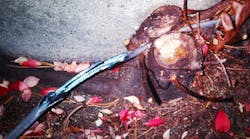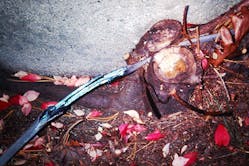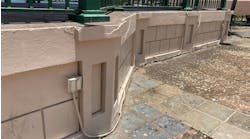How well do you know the Code? Think you can spot violations the original installer either ignored or couldn't identify? Here's your chance to moonlight as an electrical inspector and second-guess someone else's work from the safety of your living room or office. It's your turn to identify the violation.
Hint: Squeeze play
Find the Answer
At one point in time, this UF cable was buried. Unfortunately, a seed landed at the concrete base of this light pole and over time it grew into a tree, which eventually swallowed the cable and pulled it right out of the ground. Since that time, this cable has gotten stepped on and damaged to the point where it shorted out and tripped the breaker. Thankfully, the breaker did its job. Otherwise this damaged cable would have continued to present a real shock hazard.
Column 1 of Table 300.5 in the 2017 NEC requires UF cable to be buried with at least 24 in. of cover for this location. Sec. 340.12(10) prohibits this UF cable from being used in areas where subject to physical damage. It’s obvious from the photo that this cable has suffered some severe physical damage. I was able to cut the cable away from this tree base and use some listed underground splice kits — in accordance with Sec. 110.14(B) — to extend and re-route this cable away from this pole to a safe and properly buried location.





